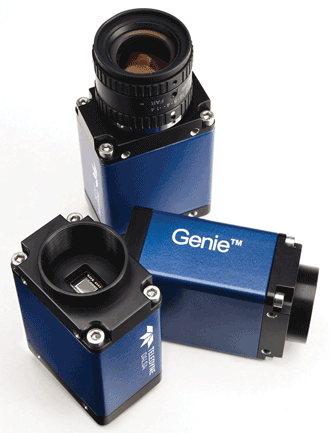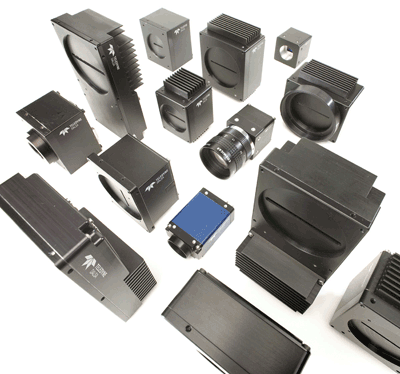Manny Romero and Robert Howison, Teledyne Dalsa
Imagine you are a systems integrator and that your customer’s vision system works just fine. It performs as expected, and everyone’s happy. But in a marketplace where all players claim quality products and affordability, how do you differentiate your solutions from your competition’s? Intangibles such as customer service or training programs can help, but they might not be enough to give you that competitive edge.
A semi-custom product might be what you’re looking for. If you have ever wondered if it is possible to reduce image data before transferring to the host computer, or wished the camera’s casing were smaller, or wished an algorithm were more efficient, a custom or semi-custom solution could be the answer.

A common customization request is to alter an existing algorithm for the Genie GigE camera.
It’s true that larger companies are more likely to have the resources to get customized products, but smaller companies are not necessarily at a disadvantage. Many requests for custom and semi-custom cameras are fairly simple and straightforward. That means that any company, large or small, can have that competitive advantage.
Before tackling the answer to when and why to ask for a custom solution, a few definitions should be clarified.
In general, a custom product is one that is designed from the ground up to meet the customer’s specifications; it’s something new for a camera manufacturer. A semi-custom camera is one where an existing product is tweaked to make it “just right” for the customer. The change can be made at any level: the camera’s hardware or firmware, or with the sensor, field-programmable gate array (FPGA), memory, inputs/ouputs or electronics. A camera could be fitted with new sensors or with custom sensors, or a generic function might be implemented in a special way to enhance processing, to improve the accuracy of timing, or to add metadata such as exposure information to the image data. A frame-grabber function might be added to the camera. Or maybe functionality a customer doesn’t need could be removed to reduce the cost of a product – for example, using a smaller FPGA.

Semi-custom solutions can be applied to both hardware and software.
Customers request semi-custom cameras for a variety of reasons. They might want to fully optimize a camera’s pre-existing function, or they might have a specific requirement or need something unique for a niche market. Maybe their goal is simply a competitive edge over their competition. If you have really assessed your application and thought, “It works just fine, but I wish it could … ,” that is when you should speak up.
Special applications
A common customization request is to alter an existing algorithm for the Genie GigE camera. One customer developed a security application that acquired images outdoors. The team explained that the images contained both very bright and very dark regions, but it was the middle-range pixels that contained the important information for their application. The scenes would be subjected to a lot of movement and constant changes in brightness. The customer was concerned that those mid-range pixels would not have enough brightness and contrast because they would be affected by the two extremes. This was a situation where a customer needed a spinoff of the standard functionality: a modification to the auto-brightness function. And because all users should benefit from this updated algorithm, the solution was provided at no cost.
Data reduction is another common customization. Run-length encoding (RLE) is useful in situations where multiple pixels in a specific region of the image have the same value. Instead of passing the value of each pixel to the host, RLE informs the software that the next 50 pixels, for example, have the same value. Instead of passing the same information 50 times, RLE passes the data once, reducing the amount of data that gets transferred. This technique has been used in a wood-inspection application, where the vision system guided a saw to cut around imperfections in the wood. In this application, the RLE was used to isolate specific regions in the image, reduce the amount of data required to represent those regions, and pass only that information down to the host for further processing and mapping of the cut zones.
That same customization was later used for a biomedical motion-capture application. The customer placed sensors on a test subject and wanted to analyze their movement through the image data. They wanted to use GigE cameras – between five and 10 of them – on the same network. The challenge was to fit all that image data on a network with a 100-MB/s bandwidth, and data reduction was the only way to do it. By modifying the camera’s firmware to use RLE, the captured images contained only the sensors, which appeared as dots. It was very easy to implement because it had been done before – though for a very different market segment.
On-camera image compression is another example of semi-custom functionality implemented for a specific customer. In this case, the client wanted to use five cameras to inspect trains without having to slow them down. To accomplish this, we needed to run all five cameras at 100 frames per second. The problem was that all that data represented too much bandwidth for a single GigE network. To get all of the image data through the same network connection, we added JPEG compression functionality to the camera’s firmware.

On-camera image compression helped one customer who wanted to use five cameras to inspect trains without having to slow them down. Images courtesy of Teledyne Dalsa and Istech.
Opportunity knocks on hardware
Hardware customizations are also an option: mechanical and form-factor changes, for example, as well as sensor modifications such as specialized coatings and filters. As with the firmware customizations, these hardware solutions came about after discussions with the customer. In one case, the customer had a system for calibrating color quality for print-inspection systems. It started out as a custom processing project, and as it progressed, it turned out that a change in form factor was also significantly helpful. The end result was a flat camera made by unfolding the printed circuit boards and replacing a flexible interconnect with a rigid section of printed circuit board. The users had not mentioned the need for months, because they assumed the form factor could not be changed. But it could, and it was.
Another hardware solution was a “mini frame grabber in a box” for a client who had multiple cameras at various locations but, because of space and distance constraints, could not use multiple sets of PCs and frame grabbers. Camera Link cables wouldn’t work, either, because they would be too long. The “frame grabber in a box” performed the client’s preprocessing and data reduction, which meant that only the processing results had to be sent out over the network.
Other customers have run into obsolescence issues with third-party vendors – for example, their suppliers had discontinued certain features in the next generation of frame grabbers. We had a frame grabber that was capable of doing the job, but the client’s existing product used cabling and connectors for the brand of frame grabber it had previously used. Modifying the connectors and pinouts on the standard frame grabber allowed seamless integration into the client’s existing product.
When to consider semi-custom
Engineers enjoy a challenge, especially when it’s something new. A long-term partnership with a customer helps, as does some level of follow-on business. That doesn’t have to mean 500 units a year, but projects with follow-on business comparable to the scope of the development are more successful all around.
In other words, we wouldn’t turn away a project if it meant only five units a year, but in that case, the development work shouldn’t require six months of an engineer’s time. The nonrecurring costs don’t have to be exorbitant, either, and sometimes the development cost can be rolled into the unit price if a client is unable to deal with an upfront nonrecurring expense.
The common thread with all semi-custom work is the communication between customer and vendor. Standard products are constantly in development, with upgrades and optimized firmware – the task list often is prioritized a year in advance. Sometimes clients ask for something that’s already in the works – next year. But if a client needs a change that’s already on the to-do list, and there is enough justification to do it sooner than planned, we will. And if it’s something that can benefit everyone, that client might even get the customization at no charge.
Meet the authors
Manny Romero is a product manager at Teledyne Dalsa in Waterloo, Ontario, Canada; email: manuel.romero@teledyne
dalsa.com. Robert Howison is an OEM group manager at Teledyne Dalsa in Waterloo, Ontario, Canada; email: [email protected].